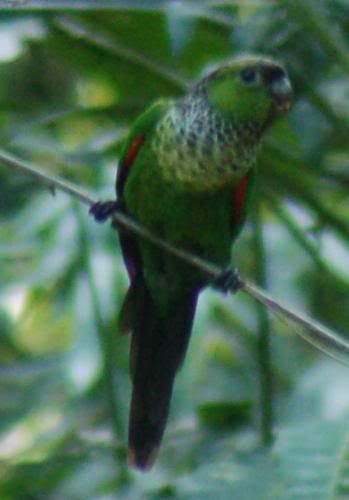Returning from my most memorable summer in the Peruvian Amazon, I have been working hard through the winter months on my Thesis. After draft, after draft etc, it's all now done and dusted now, handed in to be marked and I am now waiting on my marks.
After studying a number of different species and areas of conservation throughout my education, I have to say that this work was one of the most interesting. The thrills and spills that occurred during my data collection were a joy to behold. The constant encounters with the local wildlife was fantastic, for example being followed by groups of squirrel monkeys (Saimiri sciureus) while working is something that I will never forget. On the other hand, the regular bee stings I could do without.

A picture of a squirrel monkey, I apologise for the quality of the picture. A long summer in the jungle is not the best for my poor old camera lens.

Scarlet, and blue and yellow macaws waiting on trees before their daily fix of clay!
There is however, a more serious point to my studies. Deforestation is well known in the Amazon and continues to threaten all areas of the rainforest be it in reserves or unprotected areas. As more pristine rainforest is deforested, secondary forest may be important for parrot communities. My study assessed the abundance of parrot species in secondary forest and documented important food resources for the parrot community as a whole and for individual species.
A brief overview of some important things I found:
Habitat Associations
• Secondary forest was dominated by smaller bodied parrot species (e.g. Cobalt-winged parakeets (Brotogeris cyanoptera) and Black-capped parakeets (Pyrrhura rupicola).

A Cobalt-winged parakeet. Courtesy of Alan Lee (Tambopata Macaw Project).

A Black-capped parakeet. Courtesy of Alan Lee (Tambopata Macaw Project).
• Whereas larger bodied parrots (e.g. Scarlet macaws (Ara macao) and Mealy parrots (Amazona farinosa) were associated with primary forest.
Foraging information
• Parrots (mainly parakeets and Chestnut fronted macaws (A. severa) heavily consumed flowers of Ochroma pyramidale and Cecropia peltata and may be potential tree pollinators.
The data presented here indicates that secondary forest holds important, albeit seasonally available, food resources and attracts a significant parrot population. Although, high levels of density estimates and foraging events may be linked to seasonality. Therefore, future conservation practices should not just include pristine forest but also modified secondary forest.
So this is the end of my project work for the time being. If anyone would like a copy, please feel free to contact me and I will send you a copy, likewise if anyone would like a copy of my undergraduate thesis entitled:
'The influence of clay licks on parrot ecology, Tambopata, Peru.'
f anyone would is interested in the Macaw Project please visit the website at:
http://www.macawmonitoring.com
I am currently on the lookout for further work on parrots or birds in general so watch this space for future updates!
































